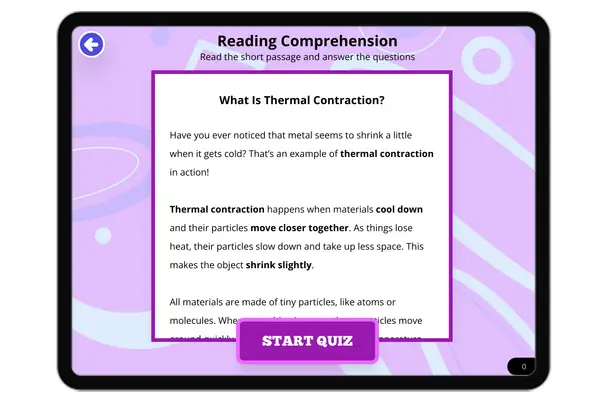Sublimation: The Solid-to-Gas Magic — Passage
Have you ever seen dry ice turn into a cloud of fog? If so, you've seen sublimation in action! Sublimation is a special kind of phase change where a solid changes directly into a gas, without becoming a liquid first. This process happens when certain solids gain enough energy to skip the liquid stage completely.
One of the most common examples of sublimation is dry ice. Dry ice is solid carbon dioxide. When left at room temperature, it doesn’t melt into liquid. Instead, it changes straight into carbon dioxide gas. That’s why you see a mist or fog forming around dry ice—it’s the gas mixing with the moisture in the air. This makes it popular for special effects at concerts or Halloween parties.
Sublimation doesn’t only happen in science labs or spooky settings. It occurs in nature, too. In cold and dry places like Antarctica or high mountains, snow and ice can change directly into water vapor. This is sublimation at work, even though you might not see it happening. The process is slow, but it helps explain how snow disappears even when the temperature stays below freezing.
For sublimation to happen, the solid must absorb enough energy to break the bonds holding its particles together. This energy usually comes from heat. The air pressure also plays a role. At low pressures, it’s easier for solids to sublimate. That’s why sublimation is more common at high altitudes or in space.
Fun Fact: NASA uses sublimation in spacesuits! Ice packs inside the suit sublimate to keep astronauts cool during spacewalks.
What is sublimation?
A gas turning into a liquidA solid turning into a gasA liquid turning into a solidA gas turning into a solidWhich substance is a common example of sublimation?
WaterIce creamDry iceLavaWhat happens to dry ice at room temperature?
It melts into a liquidIt freezes moreIt stays the sameIt turns into gasWhere in nature does sublimation often happen?
In the desertIn hot oceansIn cold, dry placesIn warm forestsWhy is sublimation more common at high altitudes?
There is more oxygenThe sun shines longerThe air pressure is lowerThe temperature is higherWhat is the main idea of the passage?
Dry ice is dangerous to touchSublimation is a unique phase changeNASA studies fogWeather changes quicklyWhat causes a solid to sublimate?
It absorbs enough energy to break particle bondsIt becomes a liquid firstIt loses all its energyIt cools down rapidlyIf a snowman slowly disappears even though it’s below freezing, what likely caused it?
RainfallSublimationEvaporationMelting










